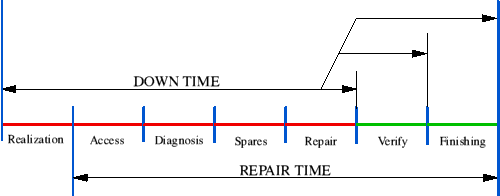Definition of Reliability
The simplest definition of reliability is long life without failure. Reliability always terminates in a failure. The formal definition of reliability is the probability that an item will perform its required function in the desired manner under all the relevant conditions and when it is required so to perform.
Reliability is described by H. Paul Barringer (2003) as "Reliability is the probability that a device, a system, or process will perform its prescribed duty without failure for a given time when operated correctly in a specified environment."
In the book Reliability, Maintainability and Risk describe and discuses Dr David J Smith some parameters that can be used to measure reliability characteristics of equipment or process.
Mean Time Between Failures (MTBF):
The MTBF are the average time between failure for given mission time. For a stated period in the life of an item the mean value of the length of time between consecutive failures, computed as the ratio of the total cumulative observed time to the total number of failures. It is often used to describe equipment or system reliability. Often use when calculating maintenance costs. Meaningful even if the failure rate is not constant. It can be confusion between MTBF and Mean Life. Whereas the Mean Life describes the average life of an item taking into account wear out. The difference is clear if one considers the simple example of the match.
The simplest way to calculate the MTBF is with the following equation where the t = mission time.
Mean Time Between Failure (MTBF)
Mean Time To Repair (MTTR):
The MTTR is the average time of total repair time for given mission time. MTTR is often expressed in percentile terms such as the 95 percentile repair time shall be 1 hour. This means that only 5% of the repair actions shall exceed 1 hour.
The simplest way to calculate the MTTR is with following equation.

Mean Time To Repair (MTTR)
Mean Down Time (MDT)
There are often confusion of the MDT and MTTR the MDT is the average time when the equipment is stopped or out of function. The MTTR are the total repair time. The figure below shows how the elements of down time and repair time are different.

Elements of down time and repair time
To calculate the Mean Down Time following equation is used.

Mean Down Time (MDT)
Failure Rate: (λ)
For a stated period in the life of an item, the ratio of the total number of failures to the total cumulative observed time. It is applicable to most component parts and is useful at the system level, whenever constant failure rate applies, because it is easy to compute Unavailability from λ x MDT. Remember, however, that failure rate is meaningless if it is not constant. The failure rate is calculated with following equation.

Failure rate
Reliability/Unreliability:
Reliability is the probability that an item will perform a required function, under stated conditions, for a stated period of time. Reliability is therefore the extension of quality into the time domain and may be paraphrased as the probability of non-failure in a given period. Used where the probability of failure is of interest as, for example, in aircraft landings where safety is the prime consideration.
The reliability is described in % value and can be calculated on different ways, if there are exponential distribution which describes random failures it can be calculated with following equation where t = mission time and λ = failure rate for the mission time. (Lusser's equation)

Lusser's equation for reliability with random failures
For deeper definition of reliability when data for a specific failure mode are known and the age-to-failure is not random it is possible to use the Weibull distribution to calculate the reliability using following equation where t = mission time, η = characteristic age-to-failure rate and ß = Weibull shape factor. The Weibull distribution will be discussed later.

Weibull distribution with known failure modes
Availability/Unavailability:
The availability is an indicator of how much time equipment or process is available for the operation to operate or perform the task that it was design for. The availability is described in % value.
Availability is very useful where the cost of lost revenue, owing to outage, is of interest.
The following equation describes the calculation of the availability.

Availability